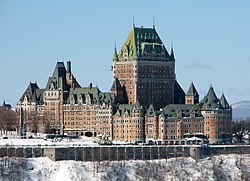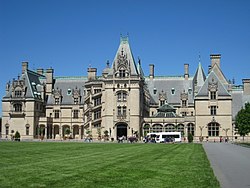



Châteauesque (or Francis I style, or in Canada, the Château Style) is a revivalist architectural style based on the French Renaissance architecture of the monumental châteaux of the Loire Valley from the late fifteenth century to the early seventeenth century.
The term châteauesque (literally, "château-like") is credited (by historian Marcus Whiffen) to American architectural historian Bainbridge Bunting, although it can be found in publications that pre-date Bunting's birth. As of 2011, the Getty Research Institute's Art & Architecture Thesaurus includes both "Château Style" and "Châteauesque", with the former being the preferred term for North America.
The style frequently features buildings heavily ornamented by the elaborate towers, spires, and steeply-pitched roofs of sixteenth century châteaux, themselves influenced by late Gothic and Italian Renaissance architecture. Despite their French ornamentation, as a revival style, buildings in the châteauesque style do not attempt to completely emulate a French château. Châteauesque buildings are typically built on an asymmetrical plan, with a roof-line broken in several places and a facade composed of advancing and receding planes.
History
The style was popularized in the United States by Richard Morris Hunt. Hunt, the first American architect to study at the École des Beaux-Arts in Paris, designed residences, including those for the Vanderbilt family, during the 1870s, 1880s and 1890s. A relatively rare style in the United States, its presence was concentrated in the Northeast, although isolated examples can be found in nearly all parts of the country. It was mostly employed for residences of the extremely wealthy, although it was occasionally used for public buildings.
The first building in this style in Canada was the 1887 Quebec City Armoury (now named the Voltigeurs de Québec Armoury, formerly called the Grande-Allée Armoury (French: Manège militaire Grande-Allée, or simply Manège militaire) designed by Eugène-Étienne Taché. Many of Canada's grand railway hotels, designed by John Smith Archibald, Edward Maxwell, Bruce Price and Ross and Macdonald, were built in the Châteauesque style, with other mainly public or residential buildings. The style may be associated with Canadian architecture because these grand hotels are prominent landmarks in major cities across the country and in certain national parks.
In Hungary, Arthur Meinig built numerous country houses in the Loire Valley style, the earliest being Andrássy Castle in Tiszadob, 1885–1890, and the grandest being Károlyi Castle in Nagykároly (Carei), 1893–1895.
The style began to fade after the turn of the 20th century, and it was largely absent from new construction by the 1930s.
Architects who designed in Châteauesque style
- John Smith Archibald of Archibald and Schofield
- Bradford Gilbert
- Bruce Price
- Edward Maxwell
- Eugène-Étienne Taché
- Francis Rattenbury
- Sproatt and Rolph
- Hippolyte Destailleur
- Richard Morris Hunt
- Ross and Macfarlane, Ross and Macdonald
- Solon Spencer Beman
- Walter-André Destailleur
- William Lightfoot Price
- William Henry Crossland
- Henry Heistand,
Examples in Europe
-
 Massandra Palace, Crimea (1900 palace)
Massandra Palace, Crimea (1900 palace)
-
 Meyendorff Castle near Moscow (1874–1885)
Meyendorff Castle near Moscow (1874–1885)
-
 Euxinograd, Varna, Bulgaria
Euxinograd, Varna, Bulgaria
United Kingdom
-
 Founder's Building, Royal Holloway, University of London, Surrey, England, 1874-1881
Founder's Building, Royal Holloway, University of London, Surrey, England, 1874-1881
-
Waddesdon Manor, Buckinghamshire, England 1874–1889
-
 Chateau Impney, Worcestershire.
Chateau Impney, Worcestershire.
-
 Halton House, Buckinghamshire.
Halton House, Buckinghamshire.
-
 Bowes Museum, County Durham.
Bowes Museum, County Durham.
-
 Cherkley Court, Surrey.
Cherkley Court, Surrey.
-
 Park Place Berkshire.
Park Place Berkshire.
-
 Minley Manor, Hampshire.
Minley Manor, Hampshire.
-
 Oxon Hoath, West Peckham, Kent
Oxon Hoath, West Peckham, Kent
Examples in the United States
-
 William K. Vanderbilt residence, Petit Chateau, 1878–82, Manhattan, by Richard Morris Hunt.
William K. Vanderbilt residence, Petit Chateau, 1878–82, Manhattan, by Richard Morris Hunt.
-
 Ochre Court, Newport, Rhode Island, 1892
Ochre Court, Newport, Rhode Island, 1892
-
 Kimberly Crest, Redlands, California, 1897, Dennis and Farwell, architects
Kimberly Crest, Redlands, California, 1897, Dennis and Farwell, architects
-
 Carey Mansion, Newport, Rhode Island
Carey Mansion, Newport, Rhode Island
-
 Biltmore Estate, 1890–95, Asheville, North Carolina, Richard Morris Hunt, architect
Biltmore Estate, 1890–95, Asheville, North Carolina, Richard Morris Hunt, architect
-
Hotel du Canada, Orlando, Florida, 1982
-
 Col. Frank J. Hecker House, Detroit, Michigan, 1888
Col. Frank J. Hecker House, Detroit, Michigan, 1888
-
 Voigt House, Part of Heritage Hill Historic District, Grand Rapids, Michigan, 1895
Voigt House, Part of Heritage Hill Historic District, Grand Rapids, Michigan, 1895
-
 Eighth Precinct Police Station, Detroit, Michigan, 1901
Eighth Precinct Police Station, Detroit, Michigan, 1901
-
 Stadium High School, Tacoma, Washington, Broke ground 1891, Completed 1906
Stadium High School, Tacoma, Washington, Broke ground 1891, Completed 1906
-
William W. Kimball House, Chicago, Illinois, 1892
-
 Overholser Mansion, Oklahoma City, 1903
Overholser Mansion, Oklahoma City, 1903
-
 Villa Riviera, Long Beach, California, 1929
Villa Riviera, Long Beach, California, 1929
Examples in Canada
See also: List of Canadian railway hotelsMany of the Châteauesque-style buildings in Canada were built by railway companies, and their respective hotel divisions. They include Canadian National Railway and Canadian National Hotels, Canadian Pacific Railway and Canadian Pacific Hotels, and the Grand Trunk Railway.
-
Banff Springs Hotel, Banff, Alberta
-
 Château Laurier, Ottawa, Ontario
Château Laurier, Ottawa, Ontario
-
 Fort Garry Hotel, Winnipeg, Manitoba
Fort Garry Hotel, Winnipeg, Manitoba
-
 Gare du Palais, Quebec City
Gare du Palais, Quebec City
-
 Hotel Vancouver, Vancouver, British Columbia
Hotel Vancouver, Vancouver, British Columbia
-
 Manoir Richelieu, La Malbaie, Quebec
Manoir Richelieu, La Malbaie, Quebec
-
 Place Viger, Montreal, Quebec
Place Viger, Montreal, Quebec
-
 Quebec City Armoury, Quebec City
Quebec City Armoury, Quebec City
-
 The Bessborough, Saskatoon, Saskatchewan
The Bessborough, Saskatoon, Saskatchewan
-
The Empress, Victoria, British Columbia
-
 The Royal York, Toronto, Ontario
The Royal York, Toronto, Ontario
See also
References
- ^ Whiffen, Marcus, American Architecture Since 1780: A guide to the styles, The MIT Press, Cambridge, MA, 1969, p. 142.
- Maitland, Hucker and Ricketts, A Guide to Canadian Architectural Styles, Broadview Press, Peterborough, Ont., 1992, p. 93.
- ^ McAlester, Virginia & Lee (1996). A Field Guide to American Houses. New York: Alfred A. Knopf. pp. 375. ISBN 0-394-73969-8.
- Stein, Susan R., ed., The Architecture of Richard Morris Hunt, University of Chicago Press, Chicago IL, 1986, p. 151.
- Maitland, Hucker and Ricketts, A Guide to Canadian Architectural Styles, Broadview Press, Peterborough, Ont., 1992, p. 94.
- Craven, Wayne (2009). Gilded Mansions: Grand Architecture and High Society. New York: W. W. Norton & Company. pp. 111–126. ISBN 978-0-393067-54-5.
External links
- Yorklinks.net: Images of Châteauesque architecture
- Ci.chi.il.us: Châteauesque style guide — images from Chicago architecture.
- Oldlouisville.com: Châteauesque homes in Louisville — images from Louisville, Kentucky.
| Historicism and Revivalism in architecture and decorative arts | |
|---|---|
| International |
|
| France | |
| Germany, Austria-Hungary | |
| Great Britain | |
| Greece | |
| Italy | |
| Netherlands | |
| Nordic countries | |
| Portugal | |
| Poland | |
| Romania | |
| Russian Empire and USSR | |
| Serbia | |
| Spain | |
| United States | |